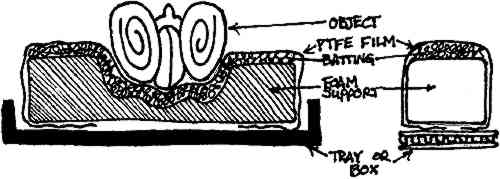THE USE OF POLYTETRAFLUOROETHYLENE (PTFE) FILM FOR STORAGE SUPPORTSNANCY ODEGAARD, MATTHEW CRAWFORD, & WERNER ZIMMT
ABSTRACT—Wide-format rolls of polytetrafluoroethylene (PTFE) film, best known as plumber's or Teflon tape, are being developed for use as a final covering on storage supports for objects with particularly fragile or vulnerable surfaces. The film's smooth and pliable characteristics are well suited to protecting fragile surfaces from abrasion and similar mechanical damage. Included in the paper are descriptions of how the film was used for rehousing projects at the Arizona State Museum. TITRE—L'utilisation d'un film de polyt�trafluoro�thyl�ne (PTFE) comme support de rangement. R�SUM�—La polyt�trafluoro�thyl�ne (PTFE), mieux connu sous le nom de ruban adh�sif du plombier ou Teflon, est employ� pour le surfa�age final des supports de rangements d'objets ayant une surface particuli�rement fragile ou vuln�rable. Le film est lisse et flexible et prot�ge de mani�re efficace les surfaces fragiles contre les abrasions et autres dommages m�caniques. Cet article d�crit comment le film f�t employ� pour le (re)stockage d'objets au Mus�e de l'�tat d'Arizona. T�TULO—La utilizaci�n de pel�cula de polytetrafluoroetileno (PTFE) en soportes para almacenamiento de piezas. RESUMEN—Los rollos de formato ancho de pel�cula de politetrafluoroetileno (PTFE), m�s conocido como cint\a de plomero o de tefl�n, est�n siendo aplicados como cobertura final de soportes para almacenamiento de objetos con superficies particularmente fr�giles o vulnerables. Las caracter�sticas de suavidad y maleabilidad del film sirven para proteger las superficies fr�giles de la abrasi�n y de da�os mec�nicos similares. En este art�culo se incluyen descripciones del uso de esta pel�cula en proyectos de reacondicionamiento en el Museo del Estado de Arizona. 1 PURPOSEMany museum collections, including ethnographic and archaeological collections, are stored in simple flat tray formats. Without supplemental support, artifacts that have flaking, powdering, spalling, and other forms of surface deterioration may experience increased damage resulting from shifting, abrasion, and impact. Traditional padding materials (cotton or polyester batting, tissue paper, or plastic foams) may expose these artifacts to additional deterioration through abrasion and because the artifact surface can catch on or entangle with them. The use of polytetrafluoroethylene (PTFE) film in storage support systems reduces these risks. 2 DESCRIPTIONPTFE film may be applied as a barrier or cover for otherwise problematic storage materials. PTFE pipe thread sealant (in a thin ribbon form) is often referred to simply as plumber's tape or Teflon tape. In this form, the tape has been used in conservation as a nonabrasive wrap for isolating overlapping or fitted elements and as a isolating membrane between objects and fills. Recently, the conservation lab at the Arizona State Museum (ASM) has adapted wide-format PTFE film for systematic rehousing projects involving large numbers of artifacts. The availability 3 CONSTRUCTION USESThe soft, smooth PTFE film acts as a final cover for a wide range of support forms. In cases where an artifact's surface may be endangered by an abrasive, clinging, or highly charged material, this film can be an effective barrier between the support and the object. For example, a recessed foam support can be prepared with a thin layer of polyester batting laid down for additional padding. Over this entire construction a sheet of PTFE film can be loosely draped. When pressed into the recessed area, the film conforms to the shape with virtually no change in dimension. The excess film may be wrapped beneath the foam to secure the package without adhesive. For contoured saddle-type supports (fig. 1), the PTFE film also works well as a flexible wrap for sandwiching layers of support materials such as foam and batting. The PTFE film secures and isolates these layers from an object's vulnerable surface without the use of adhesives. For the storage support systems described here, no adhesive was used to secure the film, but hot-melt glue is effective in adhering it to both foam supports and storage trays.
4 PRODUCT SPECIFICATIONSWe are aware of only one source for the wide-format PTFE film rolls used at ASM: Plastomer Products Company. The film is marketed as Plasti-Thread PTFE Thread Sealant Tape. Widths of up to approximately 12 in. are available. For the widest possible dimension, request that the roll be “unslit.” The projects at ASM have all used .003 mm thickness film (0.7 gauge), the thinnest film made by Plastomer Products. A thicker film used for wire insulation is also available, but we found it less useful in our projects. The chemically inert, nontoxic, nonabsorbent, and nonflammable film is priced by the pound (1 lb. = approx. 150 ft.). Plastomer Products currently requires a 10 lb. minimum order. The cost per pound varies with the market price of the raw materials. SOURCES OF MATERIALSLeonard PlewesPlastomer Products Coltec Industries, 23 Friends Lane, Newtown, Pa. 18940, (800) 618-4670 AUTHOR INFORMATIONNANCY ODEGAARD holds a Ph.D. in applied science in conservation from the University of Canberra, an M.A. from George Washington University, and a certificate in ethnographic and archaeological conservation from the Smithsonian Institution. She has been head of the conservation section at the Arizona State Museum since 1984 and is a member of the faculty of the University of Arizona. Address: Arizona State Museum, University of Arizona, Tucson, Ariz. 85721. MATTHEW CRAWFORD holds an M. Sc. in art conservation from the University of Delaware. From 1995 he was the assistant conservator at the Arizona State Museum, working primarily on an NSF-funded project to upgrade storage and documentation of archaeological organic-based objects. In July 1997 he joined the Rocky Mountain Conservation Center in Denver as objects conservator. Address: Rocky Mountain Conservation Center, 2420 S. University Blvd., Denver, Colo. 80208. WERNER ZIMMT holds a Ph.D. in chemistry from the University of Chicago and an M.Sc. in archaeology from the University of Pennsylvania. Since his retirement as research chemist from E. I. Du Pont de Nemours, Inc., in 1985, he has been affiliated with the Arizona State Museum and is currently a research associate. Address: Arizona State Museum, University of Arizona, Tucson, Ariz. 85721.
 Section Index Section Index |
